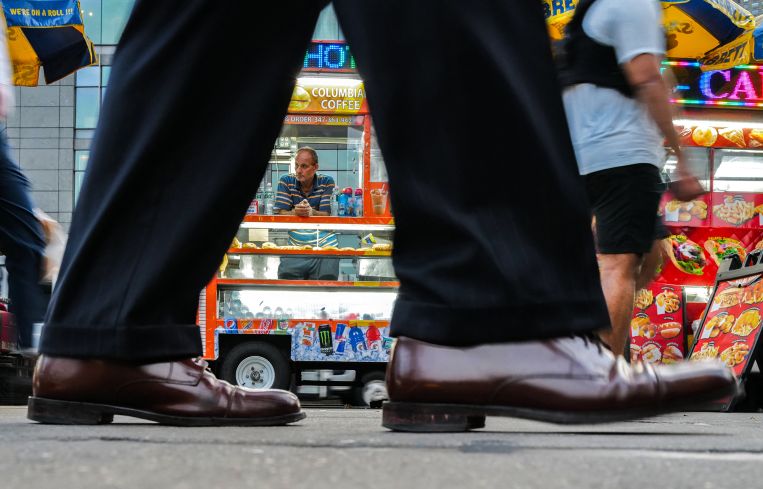Retailer Warning Signs Flashing Red Amid Inflation, Tariffs and Tourism Drops
How bad is it getting? The current Oasis tour is proving a singular lifeline for malls and stores.
By Isabelle Durso September 11, 2025 2:05 pm
reprints
A slowdown in both international and domestic tourism, as well as increased consumer caution and tariff uncertainty, is leaving many U.S. retailers high and dry.
International arrivals to the U.S., especially to major cities such as New York City, Las Vegas and Washington, D.C., are predicted to decline by 8.2 percent in 2025, according to The Associated Press.
Downtown pedestrian foot traffic to major retail hubs in the country fell by 0.5 percent in August compared to July, and by 0.2 percent compared to the year prior, according to a new report from MRI Software.
In addition, visits to U.S. shopping malls declined 2.2 percent month-over-month in August and 4.4 percent year-over-year, signaling intensifying consumer caution, MRI Software said.
Retailers have a right to be concerned with the new data, as declining tourism will likely impact several major retail hubs in the U.S.
“In certain formats and in certain cities, tourism has a significant impact on retail,” Brandon Svec, national director of U.S. retail analytics for CoStar, told Commercial Observer. “Especially border markets, gateway cities along our northern border, where we have seen such a strong and significant decline in cross-border tourism coming from Canadians. Those markets are going to be most significantly impacted.”
Pressure from current U.S. policies certainly doesn’t help the situation.
“As we create barriers to foreign goods and brands, citizens of other countries will doubtless prefer to purchase and support their own brands rather than supporting ours,” said Kate Newlin, a retail brand consultant and president of Kate Newlin Consulting.
A lot of the decline in retail foot traffic was also due to younger generations spending less time at local malls. In fact, MRI Software’s report found Gen Z is expected to reduce spending by more than 20 percent this year. That’s largely due to the popularity of generally cheaper online retailers such as Shein and Temu, and, of course, large e-commerce giants such as Amazon. In sum, many Gen Zers think there’s not really any need to go to the mall anymore.
There could be a light at the end of the tunnel, though — if retailers shape their businesses around experiences.
“August trends highlight both the pressures and the possibilities shaping U.S. retail,” Carla Hinson, vice president of solution and innovation for North America at MRI Software, said in a statement. “While declining tourism and cautious consumers are tempering growth, the surges we’ve seen around live events prove there is still a strong appetite for meaningful, experience-driven retail.”
Concerts, for example, have improved retail performance in some major U.S. cities, including Chicago, where the Oasis Live `25 Tour boosted visits by 12.9 percent in August, according to MRI Software. And, in New Jersey, retail foot traffic rose 19.4 percent week-over-week on Aug. 31 and spiked by 62.5 percent on Sept. 1 when Oasis performed at MetLife Stadium, the report found.
Those surges show cultural, sports and entertainment events have the power to affect retail performance quite positively — and malls are following suit.
“Malls have been pivoting their tenant mix to be more experiential,” said Caroline Wu, director of research at foot traffic tracker Placer.ai. “This manifests in the form of increased entertainment offerings within dining, such as ‘eatertainment’ locations that combine socializing and food and drinks.”
And with Halloween, Black Friday and Christmas shopping coming up, “retailers and landlords who align their strategies with these moments, while delivering value and accessibility, will be best positioned to capture foot traffic and maintain momentum through the fall and holiday season,” Hinson said.
But, even if retailers boost their numbers during the holiday season, there’s still a dark cloud looming over everyone’s heads: tariffs.
President Donald Trump’s tariffs on many foreign imports have finally made their mark on major retailers. Walmart, for example, posted relatively strong earnings for the second quarter of 2025, but John David Rainey, its chief financial officer, warned last month that Walmart has raised prices on many of its items.
“There are certainly areas where we have fully absorbed the impact of higher tariff costs,” Rainey said during an interview with CNBC. “There are other areas where we’ve had to pass some of those costs along. But, when you look across the basket of items, we’re certainly trying to keep prices as low as we can.”
It’s unclear how long those retailers can hang on before the impact of tariffs begins to show up on earnings reports.
“Thus far, retailers and manufacturers have been able to play fast and loose with reality to mask the financial impact of escalating costs in time for quarterly earnings announcements,” Newlin said.
“Some companies have tried to absorb the impact and not pass it along to consumers, but that can’t last because the Street demands returns,” Newlin added. “Other companies have had to take a price uptick, and that quickly impacts sales, margins and profit. With declining demand from inflation-hobbled consumers and tourists, the shell game can’t last.”
Consumer prices increased in August at their highest rate in seven months, according to federal figures released Sept. 11.
So, as tariffs add pressure on prices for some of the country’s largest retailers, consumers are increasingly growing cautious with their spending and looking for the cheapest deals. Where do they turn? Dollar stores.
Dollar stores have performed exceedingly well in the past few quarters as some “big-box shoppers have traded down to dollar stores due to their low prices and expanded assortments,” Elizabeth Lafontaine, director of research at Placer.ai, told CO last week.
Dollar Tree, in particular, reported $4.6 billion in net sales for the second quarter of 2025 — a 12.3 percent increase from the same period last year — and a gross profit of $1.6 billion, a 12.9 percent increase, according to the company’s most recent earnings report. A 3 percent increase in foot traffic during that period drove those numbers .
Plus, given the recent Bureau of Labor Statistics report saying the U.S. created 911,000 fewer jobs in the 12 months through March 2025 than initially reported, consumers worried about job opportunities are even less willing to spend money at big-box stores.
“There is a shudder going through the consumer psyche,” Newlin said. “They know higher prices are here and more will follow. They sense — if they’ve not experienced it directly in their own or their children’s employment prospects — that personal economic optimism is not on the radar, no matter how often they are told by cheerleaders that ‘all will be well.’”
CoStar’s Svec agreed, saying the health of the consumer should be retailers’ “north star,” even more so than the state of policies and tariffs.
“None of that is going to matter if the consumer starts to face a significantly deteriorating employment market, given the fact that consumer savings are at such low rates and consumer debt levels are at such high levels,” Svec said.
Isabelle Durso can be reached at idurso@commercialobserver.com.


